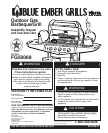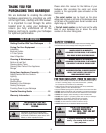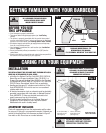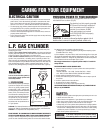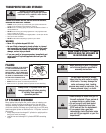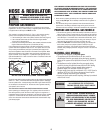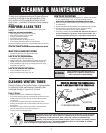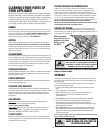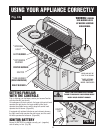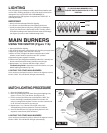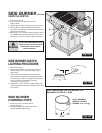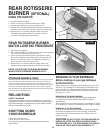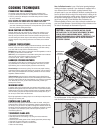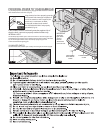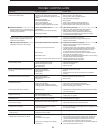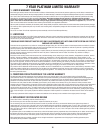Special offers from our partners!

Find Replacement BBQ Parts for 20,308 Models. Repair your BBQ today.
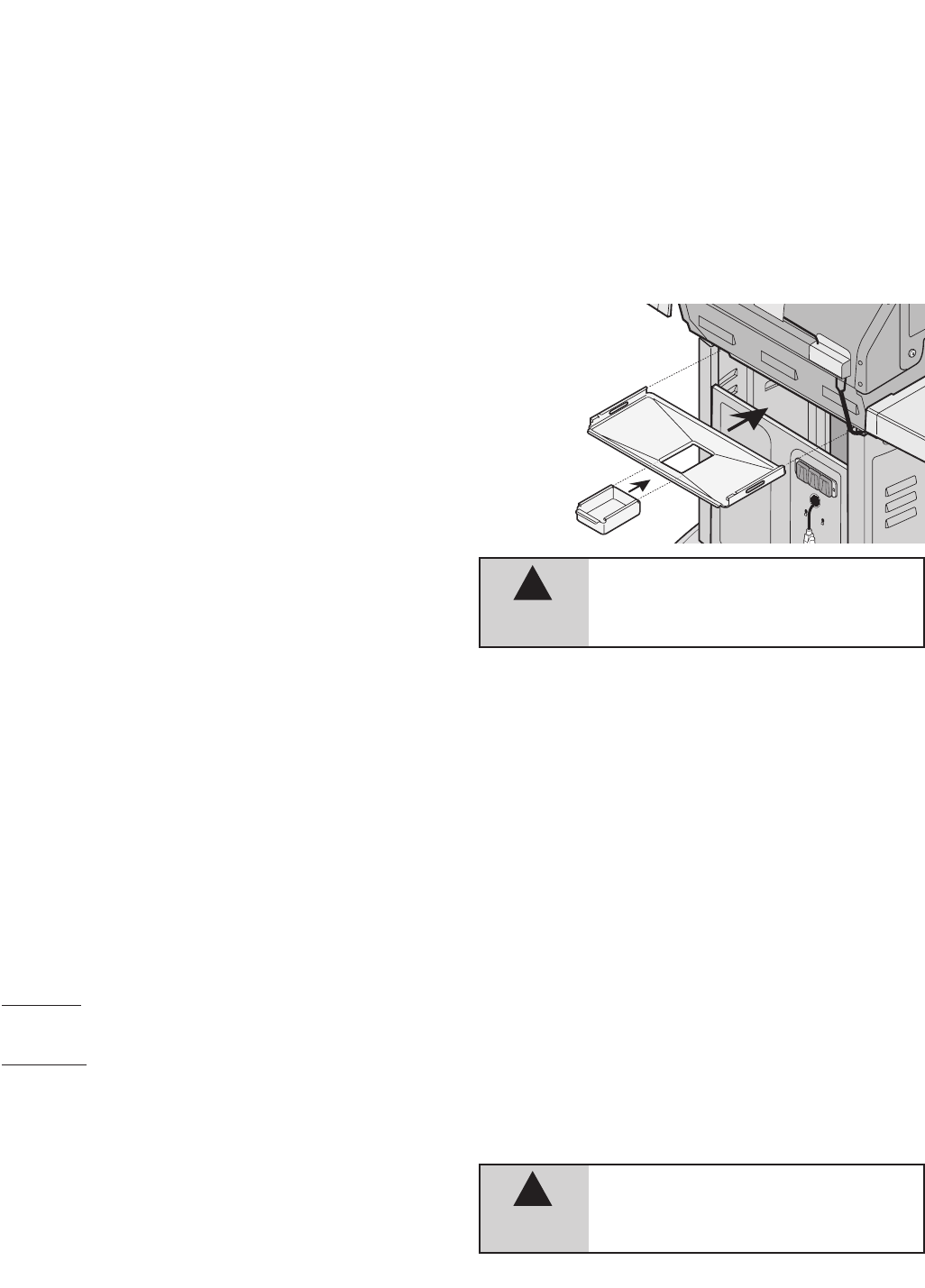
CLEANING OTHER PARTS OF
YOUR APPLIANCE
General Grill Cleaning: Do not mistake brown or black accumulation
of grease and smoke for paint. Interiors of gas grills are not painted
at the factory (and should never be painted). Apply a strong solution
of detergent and water or use a grill cleaner with scrub brush on
insides of grill lid and bottom. Rinse and allow to completely air dry.
Do not apply a caustic grill/oven cleaner to painted surfaces.
BURNER:
At least twice a year, clean your burner when cleaning the venturi tubes. The
burner can be gently scraped clean with a brass bristle brush. Ensure that all
burner ports (openings) are clear (DO NOT ENLARGE BURNER PORTS). If you
find cracks, abnormal holes, or damage caused by corrosion during your
inspection and cleaning, replace burner. (SEE WARRANTY).
IGNITOR:
Clean the ignitor clip lightly using a wire brush to remove rust and grease.
DO NOT USE WATER OR CLEAN THE ELECTRODE WITH THE WIRE BRUSH.
Visually inspect the ceramic of the electrode for cracks. The electrode can be
wiped with a soft cloth if necessary. If a crack is found, a replacement ignitor
system will be required.
CLEANING GRIDS:
After each use, scrub the cooking grids with a stiff long-handled brass brush. Do
not use steel brushes, as they can scratch the nickel or porcelain coating. Grids
can also be washed with mild detergent. Never use commercial oven cleaners.
If rust appears on your cooking grids, remove the rust with a scrub pad and
coat the grid with some cooking oil. If excessive wear is evident, you might
want to replace or upgrade your cooking grid.
PORCELAIN SURFACES:
Because of glass-like composition, most residue can be wiped away with baking
soda/water solution or specially formulated cleaner. Use nonabrasive scouring
powder for stubborn stains.
PAINTED SURFACES:
Wash with mild detergent or nonabrasive cleaner and warm soapy water. Wipe
dry with a soft nonabrasive cloth.
STAINLESS STEEL SURFACES:
To maintain your grill's high quality appearance, wash with mild detergent and
warm soapy water and wipe dry with a soft cloth after each use. Baked-on grease
deposits may require the use of an abrasive plastic cleaning pad. Use only in
direction of brushed finish to avoid damage. Do not use abrasive pad on areas
with graphics.
SIDE SHELVES:
Metal Shelves: Use any household cleaner, except those containing acid or
mineral spirits. Be sure to rinse well after cleaning.
DO NOT USE AS A CUTTING BOARD.
Plastic Shelves: Wash with warm soapy water and wipe dry. A Do not use
citrisol, abrasive cleaners, degreasers or a concentrated grill cleaner on
plastic parts. Damage to and failure of parts can result.
PLASTIC PARTS:
Wash with warm soapy water and wipe dry. A Do not use citrisol, abrasive
cleaners, degreasers or a concentrated grill cleaner on plastic parts. Damage
to and failure of parts can result.
8
CASTING INTERIOR AND WARMING RACK:
At least once a year remove all components from inside your barbeque.
Loosen any cooking residue with a scraping tool for large particles and a
brass barbeque brush for smaller particles. Scrub with hot water and a
strong detergent, then rinse thoroughly or spray barbeque degreaser liberally
on all interior surfaces. Be sure to use gloves and eye protection. Let stand
for 10 minutes, scrape off residue and repeat if required. Rinse thoroughly
with water. Replace all components as outlined in the assembly instructions.
DO NOT USE DEGREASER ON PAINTED OR PLASTIC SURFACES.
DO NOT ALLOW EXCESSIVE GREASE OR OTHER RESIDUE TO BUILD UP ON
YOUR COOKING SYSTEM AS A FIRE MAY RESULT.
GREASE CUP HOLDER: The grease cup holder is located on the
bottom of the base casting, immediately below the hole through which any
grease will drain. The grease cup should be checked and replaced regularly to
prevent grease from overflowing.
COVER YOUR BARBEQUE WHEN IT IS NOT IN USE TO PROTECT THE SHELVES
FROM THE OUTDOOR ELEMENTS.
STORAGE
More people are discovering the pleasure of year round barbequing. However, if
you choose to store your barbeque for the winter or any extended length of time,
follow these steps:
• Clean the cooking grids, then oil lightly with cooking oil, wrap in paper and
then store the cooking grids indoors.
• Follow the same cleaning method above for the burners and any warming
racks.
• Cover the barbeque if it is left outdoors.
• When the barbeque is not in use, the gas must be turned off at the L.P.
cylinder valve or main shut off valve, and stored outdoors in a
well-ventilated area.
1. With a Propaneappliance you can store the barbeque inside, PROVIDED
the cylinder is removed from the barbeque and stored outdoors in a
well-ventilated area, out of the reach of children. When the cylinder is
disconnected from the barbeque, ensure the cylinder valve safety cap is firmly
threaded through onto the valve.
2. With a Natural Gas appliance, the gas must be turned off at the individual
gas shut off valve and the hose must be disconnected from the gas supply
piping system before storing the barbeque indoors. Install plastic covers
to quick connect fittings.
After a period of storage or non-use a leak test should be performed and the
burner venturis cleaned prior to use.
Ensure grease
trap and cup are in
position and clean
before using
the BBQ.
WARNING
!
Ensure that grease trap and cup are emptied
after each use. If excess grease is allowed to
accumulate, a possible fire causing property
damage or serious injury may occur.
DANGER
NEVER STORE A SPARE LP CYLINDER
UNDER OR NEAR THE APPLIANCE OR
IN AN ENCLOSED AREA.
!



